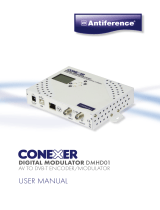
30
ENGLISH
5.1.7 MEASURES MENU
By means of the MEASURES TPE menu, it is possible to display some information about the bitrate and the
module temperature. The available menus are as follows:
SOFTWARE VERS. – in one reading, it provides the software version installed on the module.
BITRATE – allows one to know the measurements carried out on the bitrate of the multiplex of output channels.
In particular, it allows one to display:
• BITRATE USED, provides a measurement in bit/s of the bitrate totally used by the channels present in the
output multiplex,
• BITRATE AVAIL., provides a measurement in bit/s of the total available bitrate in the output multiplex with
inserted channels,
• BR. USED PEAK, provides a measurement in bit/s of the peak of maximum bitrate used by the channels
present in the output multiplex,
• BR. AVAIL.PEAK, provides a measurement in bit/s of the total available bitrate peak in the output multiplex,
• RESET BR. PEAKS, resets the peaks to the initial values calculated according to the COFDM modulation
settings. This function should be used after a bitrate overflow, after which the peaks have reached their limit
value,
• OVERFLOW ALARM indicates if a bitrate overflow has taken place. In particular, if this flag is ON, an alarm
took place, whilst the flag is OFF in normal functioning operations. By cancelling the overflow alarm, the
module is taken back to the standard operational conditions (the red LED is switched OFF).
TEMPERATURE – allows one to know all the conditions of the module’s internal temperature, that is:
• TEMP. MOD.CORE, in read-only mode, provides direction about the module’s functioning zone. There are
two operation thresholds and three operation zones:
• NORMAL: no alarm indication;
• HIGH: the red LED flashes rapidly to indicate an anomaly, but the module continues operating properly;
• CRITICAL: the red LED is on and the module is switched off. After switching it off, with regular inter-
vals of about 10 minutes, the module is switched on again and the temperature is rechecked.
• OVERTEMP. ALARM, provides an indication of the temperature alarm event. If you enter the critical tempera-
ture zone, an alarm flag is set in this submenu. It signals the temperature alarm event. This flag can be reset
only by the TPE; after resetting the flag, the red LED switches off.
5.2 INDICATIONS FOR PROGRAMMING
NOTE: Before proceeding with the programming of the module you should follow these general guidelines
1. decide if you want to use the ALL PID OUT or individually programmed programs (PID) which should be
available in output; in ALL PID OUT set status most utilities will be disabled (i.e. LCN management, Overflow
management, single PID management, etc)
2. decide if you want to use Back-panel TS (parallel) or ASI serial TS (only for SIG7121 module);
3. for individual PID program available to the output, please follow the indication below.
Programming and setting the modulation parameters of the New Headline module must be carried out carefully
in the following mode. In particular, the total bitrate of the output programs must be lower than the maximum
threshold defined by the COFDM modulation parameters. Pay attention to the ALL PID OUT selection: if the total
bitrate of the output programs overcomes the accepted bitrate, the module generates a bitrate overflow event. In
ALL PID OUT status selection it should risk failure in the showed video programs (scramble effect on low priority
programs).
To know the maximum available bitrate, refer to the following tables where the bitrate values in bit/s are shown
according to a few COFDM modulation parameters (constellation, FEC, guard interval). The shown measures
refer to an output bandwidth equal to 8 MHz. The values will be lower if a width of 6 MHz or 7 MHz is set.



















